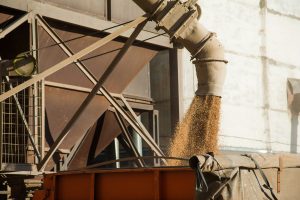
Material handling equipment can help store, move, and process large volumes of material. It increases production speed and helps prevent some risks of manual processes: injury, human error, or exposure to chemicals and hazardous materials.
There are many types of material handling equipment, and some machines are even customized for particular processes. However, these can be divided into four general categories that serve a specific purpose in the production line.
Bulk material storage equipment
This is one of the most common types of material handling equipment and is used in even the smallest and simplest facilities. As the name implies, it is used to store raw materials before they are transported or used in production.
The most basic storage and handling equipment are drawers, racks, and stacking frames. Larger warehouses may use mezzanines or elevated floor systems that can hold more materials.
The best storage and handling equipment will maximize space, prevent damage to the materials, and make it easier for workers to safely and easily access what they need.
Bulk material handling equipment
This is a broad term for any type of material handling equipment used to move or process bulk powders or solids. Examples include:
- Silos: This is a tower used for storing grains and other food products, coal, wood chips, sawdust, sand, metal waste, and more. Interestingly, this is one of the oldest types of material handling equipment—the first stone silos date back to 1700-1800 BC.
- Hoppers: This cone-shaped vessel helps funnel material from one stage of production to the other. It is typically used for particulate matter or any material that can flow. However, many materials can become compact because of moisture content, or the size and shape of the particles.
- Conveyor belts: This automatically transports materials over several feet, even through steep inclines.
- Reclaimers: This has a rotating scoop that gathers loose material and places it on a conveyor belt.
- Bucket elevators: This is used to vertically haul powder or free-flowing materials such as grains, sugar, limestone, etc.
Engineered Systems
This works with other types of material handling equipment to automate the storage and transportation of material. This includes Automated Storage and Retrieval Systems (AS/RS), Automated Conveyor Systems, Robotic Delivery Systems, and Automatic Guided Vehicles.
Material Flow Aids
One of the biggest challenges of bulk material handling is how to ensure reliable, first in/first out flow. Many bulk powders and solids can settle and become compact during storage. Others are prone to bridging and ratholing, which blocks the discharge outlet.
Material flow aids break up the material blocks and push material through the vessel. Types of material flow aids include:
- Pneumatic flow aids that use air pulses (ex: AirSweep, fluidizers, air cannons)
- Industrial vibrators that use mechanical agitation (ex: vibrators, air hammers)
- Chemical flow aids that are mixed into the material to change its flow properties (ex: fumed silica, magnesium stearate)
Among all these types of material handling equipment, AirSweep has proven to deliver the best results at lower costs. Unlike other pneumatic flow aids, it can activate even sticky, heavy, and moist materials. It uses less energy and does less damage to vessels than vibrators, and does not compromise the product formula like chemical additives.
Discover the difference between AirSweep and other types of material handling equipment in this in-depth flow aid competitive analysis. You can also contact us to find out how AirSweep can help improve your productivity, product quality, and plant safety.





Comments are closed